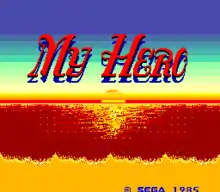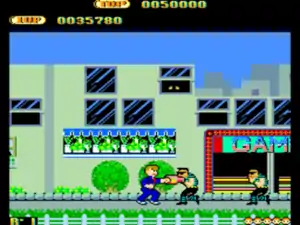My Hero (video game)
My Hero (Seishun Scandal in Japan) is a side-scrolling beat 'em up released by Sega via arcade in 1985 and for the Master System in 1986.
| My Hero/Seishun Scandal | |
|---|---|
 Title screen | |
| Developer(s) | Coreland (Arcade) Sega (Master System) |
| Publisher(s) | Sega |
| Designer(s) | Coreland |
| Platform(s) | Arcade, Master System |
| Release | 1985: Arcade 1986: Master System |
| Genre(s) | Beat 'em up |
| Mode(s) | Single player Two player alternating |
| Arcade system | Sega System 1 |
Gameplay

The arcade version consists of three different levels, each continuing in an endless loop until the player runs out of lives. It starts out with the player character (named Steven according to the arcade flyer, Takeshi in Japan) on a city street watching as a street thug runs off with his girlfriend (named Remy, also according to the arcade flyer, Mari in Japan). As he pursues him, he must fight off gangs of other various street thugs. Halfway through the level, Steven has an opportunity to save a captive bystander who (if rescued) will help him fight until the bystander is killed. Soon (after jumping across platforms and dodging fireballs) Steven arrives on a beach and fights the thug that has captured Remy. After the level boss is defeated by after being hit 10 times, the level is complete. This same process repeats for the remainder of the game, only with two other bosses and stage designs. The second stage design resembles an Edo Japanese ninja epic, with ninja themed enemies and boss, followed by a sci-fi theme loosely based upon Planet of the Apes, including ape/human enemies and a boss.
Due to space limitations on the Sega Card, the Sega Master System port only features the street gang in 3 stages that go in a continuous loop until the player loses all lives and gets a game over. The ninjas and the ape/human enemies from the arcade version are omitted.
Reception
In Japan, Game Machine listed My Hero on their August 1, 1985 issue as being the most-successful table arcade unit of the year.[1]
References
- "Game Machine's Best Hit Games 25 - テーブル型TVゲーム機 (Table Videos)". Game Machine (in Japanese). No. 265. Amusement Press, Inc. 1 August 1985. p. 25.